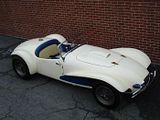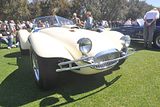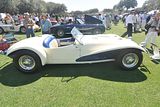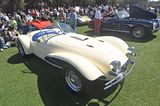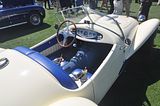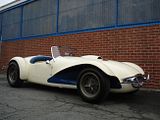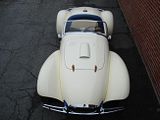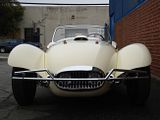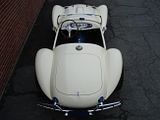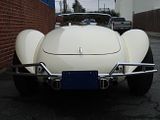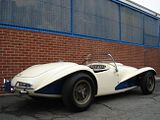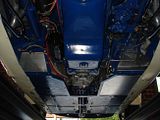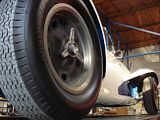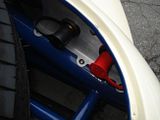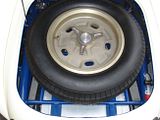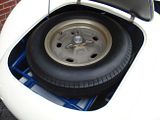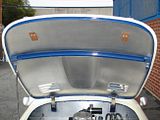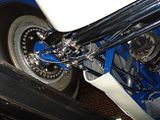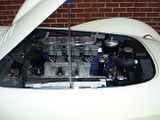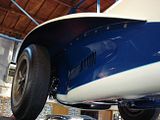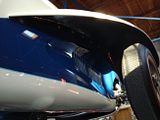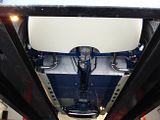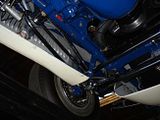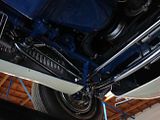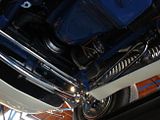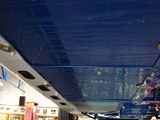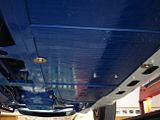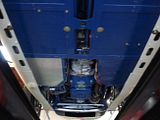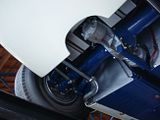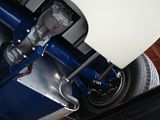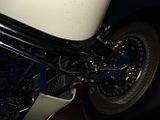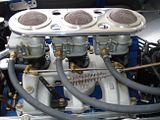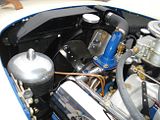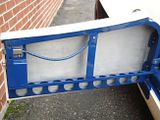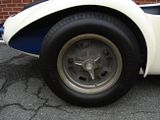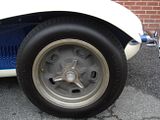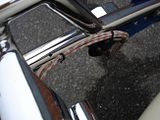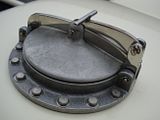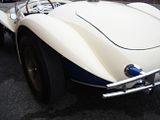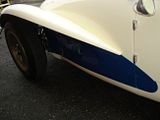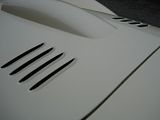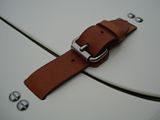Emil Diedt is one of those largely unsung heroes from American automotive history. Despite having worked for Lance Reventlow's Scarab project, with Sterling Edwards on the Edwards Specials and Edwards America, and on numerous other sports and racing cars – as well as being described by Dean Batchelor as the best metalshaper in the business – few mentions of the craftsman ever go beyond his work as a fabricator of Indy cars.
However, he was much more than that, as we see from the Rochester Special that Gerry Swetsky spotted at this year's Amelia Island Concours d'Elegance and shared with us via the Hemmings Nation Flickr pool. Built in 1950 for actor Eddie Anderson – Rochester van Jones on the Jack Benny Show – so Anderson could go sports car racing, Diedt constructed it on a Roger Evans Bacon design using a tubular chassis, aluminum body panels, a tri-power Cadillac 331-cu.in. V-8, a Lincoln manual transmission, a Halibrand quickchange rear, transverse leaf-spring suspensions front and rear, and Alfa Romeo brakes.
Anderson owned it for the next decade, then it passed through a few hands until it ended up for nearly 40 years on a flatbed trailer in the California desert. The Rochester Special's restoration was entrusted to Steve Moal, and it is today owned by Jim and Stacey Weddle of St. Louis.
By the way, if anybody can point us to a full biography of Diedt, we'd appreciate it. We do know that he was active as a coachbuilder as early as 1936 and that he maintained a shop at 5822 West Washington Boulevard in Culver City, California.
Source: Hemings |
|
1950 Emil Diedt `The Rochester Special`
Custom built car, no chassis number assigned
White with Blue Scallops with Blue and White Leather
| Exterior Color |
White with Blue |
| Interior Color |
White and Blue Leather |
| Engine |
Cadillac 331 V8 |
| Transmission |
Tremec 5 Speed |
In the early 1950s, Southern California was a hotbed for Indy Car manufacturers, designers, and fabricators, and for quite a few years, the majority of the cars in the Indianapolis 500 starting field were built in Southern California. These builders included Quinn Epperly, the Conzi Brothers, Frank Kurtis, and Emil Diedt.
Many wealthy and influential individuals living and working in the Hollywood area such as James Dean, Steve McQueen, Paul Newman, and Eddie Anderson developed an interest in sports and racing cars during this era.
By the late 1940s Eddie Anderson, a popular comic actor who stared in nearly 60 motion pictures and played the roll of Rochester van Jones in the long running Jack Benny Show, was looking for the ideal weapon with which to compete in Sports Car Club of America races. With plenty of funding on hand, Anderson commissioned famed Indy Car fabricator Emil Diedt to carry his very own concept initially drawn up by Anderson`s friend and fellow racing aficionado Roger Evans Bacon. After over two years of hard work by Diedt, this design became the Emil Diedt/Rochester Special, named after Eddie Anderson`s roll on the Jack Benny Show.
Diedt had an impressive resume including a long list of successful racing cars such as the Miller Fords, Blue Crown Special, Nat Round`s rear-engine Offy, the Brady Special, and the Novi Indy Cars. The Rochester Special was a new departure for him in that it was a sports car, rather than an Indy Car. Looking very much like a street legal Indy Car, the Rochester was the first sports car to employ twin tube frame rails that extended through the fenders providing mounts for removable bumpers. Diedt had his aluminum expert Charlie Faw craft this remarkable one-of-a-kind body. Power was supplied by a Cadillac overhead valve 331 c.i. V8, and fed though Lincoln manual transmission to the Halibrand quick-change rear end. The car was built up with Alfa Romeo drum brakes, as domestic drum brakes were known to overheat and fade when used heavily in race events. A Norden type steering apparatus was used. The suspension was a radius rod and tubular shock affair with transverse leaf springs front and rear. The expense to build was over $20,000 when new, which was more than almost any other sports or competition car, domestic or foreign, available at the time!
Over the next decade Eddie Anderson enjoyed the car very much, so much so that it required a restoration by 1960. At that time he took the car to Bill Moore Imports in South Beach, California who began a restoration. Interestingly, Anderson defaulted on the bill and Moore had to put a mechanics lien on the car and eventually sold it to Don Ingle. Ingle sold the car to his friend Dutch Covey, who got the car running, but traded it for a Model A pickup. The car next appeared twenty years later in nearby Colma, California when the owner at the time, David Butterfield, had it apprised by Steve Cram for possible sale. Mr. Cram found the car to be apart, but largely complete, with all major components in good overall condition.
The current owner purchased this wild creation in 2002 and commissioned respected professional Steve Moal, of Oakland, California to complete a ground up, show quality restoration.
Today, the Emil Diedt Roadster is finished in its original white with blue scallops, and fitted with a 331 Cadillac V8 as it was in 1950. The engine is a fully tuned unit with Offenhauser heads, an Edelbrock manifold, and two three barrel carburetors. A more modern Tremec 5-speed has been installed, whereas the Halibrand quick-change remains, along with the Alfa Romeo aluminum drum brakes. Period correct Magnesium kidney bean wheels are fitted. The restoration was a no expense spared effort, with costs totaling $300,000!
The car is immaculate in appearance and virtually perfect in every way. The paint and body work is outstanding. Much of the suspension parts have been chrome finished. The interior is trimmed in high quality tuck and roll leather upholstery and is complete with Smith Warner gauges and a period correct wood rim steering wheel. The engine bay and trunk are both fully detailed and are beautiful displays of Moal`s incredible craftsmanship.
The car drives as good as it looks. The seating position is comfortable for large drivers. The engine supplies more than enough torque and the Alfa brakes are effective. The Tremec 5-speed transmission makes gear changes a joy, and the suspension is progressive and well balanced.
With this car comes an impressive three ring binder with period photos, pre-restoration photos, photos in process, hand written letters from previous owners confirm the history as outlined above, the April 1951 Road and Track magazine which features this car, issue 104 of Speed and Sport, also featuring this car, the original copy of Steve Cram`s appraisal from 1989 discussing its condition prior to restoration, and a myriad of other notes sure to be of interest to the new owner.
As an attention getting entry to many of the historic sports car rallies, or as a vintage racing car, Emil Diedt`s Rochester Special will undoubtedly prove to be both fun to use, and an interesting conversation topic.
Source: Fantasy Junction |
|

